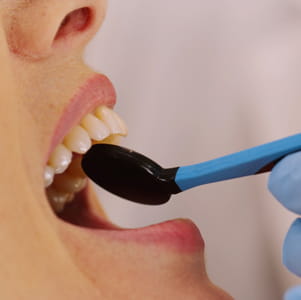BACKGROUND: Mrs P is a 65-year-old former smoker with a history of periodontal disease and bone loss. She visits her dentist, Ms N, with a painful lower right second molar. Ms N diagnoses periodontal abscess. The tooth is removed and postoperative instruction given.
Two weeks later Mrs P returns to the surgery complaining of pain and a “sour taste” in the lower right quadrant. An infected socket is diagnosed and the socket is irrigated and drained appropriately. Ms N prescribes a course of antibiotics but after four weeks the socket is still very inflamed. On radiograph the socket appears clear and normal although there is obvious bone loss around the adjacent molar.

In a later review appointment Ms N notes that healing is better but still not complete. A further review is scheduled for one month and at this appointment Mrs P now complains of pain in the adjacent lower right first molar. Ms N notes pus around the gum margin and that the adjacent socket is still inflamed. She extracts the first molar and again provides postoperative instruction.
Three weeks later Ms N notes that the first molar socket is healing well but the second is still very inflamed. More antibiotics are prescribed and another review is scheduled. At that appointment it is found that healing in the second molar socket is still not complete and Ms N observes that the inflamed tissue seems “red and cobbly”. She makes a standard dental hospital referral.
An incisional biopsy one month later at the hospital confirms the lesion is squamous cell carcinoma. The patient undergoes extensive surgery followed by facial reconstruction and radiotherapy.
A letter of claim from solicitors acting on behalf of Mrs P is sent to the surgery alleging clinical negligence in the delayed diagnosis and referral for suspected oral cancer. It is claimed that had the condition been diagnosed and treated earlier the patient would have been spared radical surgery and the need for radiotherapy.
ANALYSIS/OUTCOME: MDDUS commissions two expert reports. A GDP expert considers the care provided by Ms N and supports the decision to extract the second molar given the patient’s history of periodontal disease and the radiographic evidence of bone loss. He also finds nothing inappropriate in the initial diagnosis and treatment of an infected socket and a suggestion that infection in the adjacent molar may have contributed to the slow healing.
The expert does however question why Ms N did not consider something more than just a slow-healing socket – especially when the adjacent molar had been extracted with normal healing. His view is that a referral should have been made at this point and certainly an urgent referral at week 18.
An expert report on causation (the consequences of any breach in duty of care) by an oral maxillofacial surgeon is also not supportive of Ms N’s care. In his opinion the cancer would have been present before the first extraction and the failure to act on the abnormal healing contributed to the delay in diagnosis. This was further exacerbated by the lack of an urgent referral at 18 weeks.
The question of an earlier diagnosis leading to less radical treatment is not so clear cut. The expert states that the necessary surgery (involving tracheostomy, neck dissection, access and free-flap reconstruction) would likely have been similar in scale if carried out earlier but the tumour would have been smaller and subsequent radiotherapy might not have been indicated. Prognosis in oral cancer is obviously better the earlier the diagnosis.
MDDUS negotiates a settlement in the case with the agreement of the member.
KEY POINTS
- Have a high index of suspicion in persistent mouth ulcers and slow-healing tooth sockets.
- Ensure urgent referral in any suspicion of oral cancer.
- Consider how chronic periodontal disease might mask other acute presentations.
This page was correct at the time of publication. Any guidance is intended as general guidance for members only. If you are a member and need specific advice relating to your own circumstances, please contact one of our advisers.
Save this article
Save this article to a list of favourite articles which members can access in their account.
Save to library
